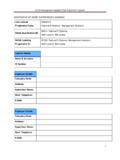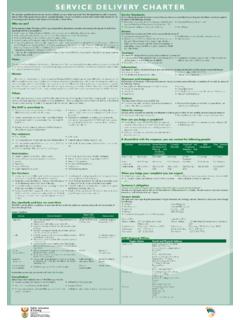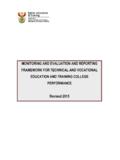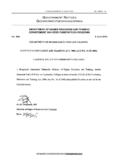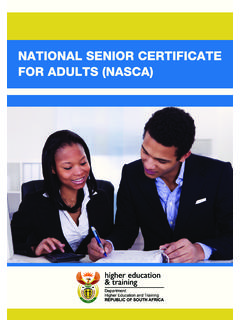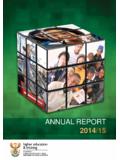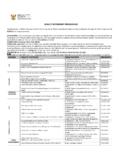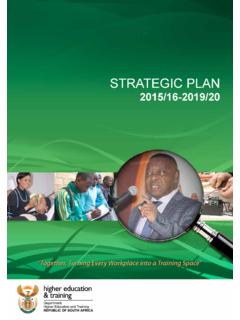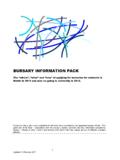Transcription of NATIONAL SENIOR CERTIFICATE FOR ADULTS …
1 NATIONAL SENIOR CERTIFICATE FOR ADULTS NQF LEVEL 4 draft subject STATEMENT mathematical literacy 1 mathematical literacy Contents mathematical literacy .. 1 mathematical literacy .. 2 INTRODUCTION .. 2 mathematical literacy .. 2 Some key requirements for mathematical literacy .. 4 1. mathematical literacy requires the use of some basic mathematical skills, concepts and content.. 4 2. mathematical literacy requires non-contrived real-life contexts.. 4 3. mathematical literacy requires communication and decision making skills.. 4 4. mathematical literacy problem solving requires the integration of content.
2 4 and/or skills.. 4 5 EXIT LEVEL OUTCOMES .. 6 ELO 1 Use numbers and their relationships to estimate, calculate and investigate the financial aspects of personal, business and social life in order to solve problems in real contexts.. 6 ELO 2 Recognise, analyse, interpret, describe and represent various functional relationships in order to solve problems in real contexts.. 6 ELO 3 Use measurement to estimate and calculate physical quantities in order to describe and represent properties of and relationships between 2D and 3D objects.. 7 ELO 4 Collect, summarise, represent and analyse data and apply knowledge of statistics and probability in order to communicate, justify, predict and critically analyse results and draw conclusions.
3 7 ASSESSMENT CRITERIA (AC) FOR EXIT LEVEL OUTCOMES .. 8 mathematical literacy assessment taxonomy .. 15 DESCRIPTION OF THE LEVELS IN THE mathematical literacy ASSESSMENT TAXONOMY .. 15 SCHEME OF ASSESSMENTS .. 17 Weightings for Content Areas .. 18 Weightings for Taxonomy Levels .. 18 CONTENT 19 Contexts .. 20 CONTENT AREAS .. 21 FORMULA 35 GLOSSARY .. 36 2 mathematical literacy INTRODUCTION The Department of Higher Education and Training provides qualifications for ADULTS and out of school youth as part of contributing to the NATIONAL Skills Development Strategy 111. This qualification is known as the NATIONAL SENIOR CERTIFICATE for ADULTS (NASCA) and is offered at Level 4 on the General and Further Education and Training Qualifications sub-framework.
4 This qualification is aimed primarily at candidates in the age group 18 to 55 years old. mathematical literacy mathematical literacy provides candidates with an awareness and understanding of the role that mathematics plays in the modern world. mathematical literacy is a subject driven by life-related applications of mathematics. It enables candidates to develop the ability and confidence to think numerically and spatially in order to interpret and critically analyse everyday situations and to solve problems. The inclusion of mathematical literacy as a fundamental subject in the NASCA curriculum will ensure that our citizens of the future are highly numerate consumers of mathematics.
5 In the teaching and learning of mathematical literacy , candidates will be provided with opportunities to engage with reallife problems in different contexts, and so to consolidate and extend basic mathematical skills. Thus, mathematical literacy will result in the ability to understand mathematical terminology and to make sense of numerical and spatial information communicated in tables, graphs, diagrams and texts. Furthermore, mathematical literacy will develop the use of basic mathematical skills in critically analysing situations and creatively solving everyday problems. In everyday life a person is continually faced with mathematical demands which the adolescent and adult should be in a position to handle with confidence.
6 These demands frequently relate to financial issues such as hire-purchase, mortgage bonds, and investments. There are others, however, such as the ability to read a map, follow timetables, estimate and calculate areas and volumes, and understand house plans and sewing patterns. Situations, such as in cooking and the use of medicine, requiring the efficient use of ratio and proportion, 3 are encountered on a daily basis. Hence, mathematical literacy is required by a self-managing person. The workplace requires the use of fundamental numerical and spatial skills in order to efficiently meet the demands of the job.
7 To benefit from specialised training for the workplace, a flexible understanding of mathematical principles is often necessary. This numeracy must enable the person to, for example, deal with work-related formulae, read statistical charts, deal with schedules and understand instructions involving numerical components. Such numeracy will enable the person to be a contributing worker. To be a participating citizen in a developing democracy, it is essential that the adolescent and adult have acquired a critical stance with regard to mathematical arguments presented in the media and other platforms.
8 The concerned citizen needs to be aware that statistics can often be used to support opposing arguments, for example, for or against the use of an ecologically sensitive stretch of land for mining purposes. In the information age, the power of numbers and mathematical ways of thinking often shape policy. Unless citizens appreciate this, they will not be in a position to use their vote appropriately. Therefore, the NASCA mathematical literacy should enable the candidate to become a self-managing person, a contributing worker and a participating citizen in a developing democracy.
9 4 Some key requirements for mathematical literacy 1. mathematical literacy requires the use of some basic mathematical skills, concepts and content. The mathematical content required is limited to some basic mathematical concepts and skills that are in essential in making sense of real life scenarios that require an understanding of numerical and statistical concepts in the daily lives of individuals and the workplace. 2. mathematical literacy requires non-contrived real-life contexts. The contexts that candidates should be exposed to in mathematical literacy should be non-contrived ( taken from actual and real situations) and relevant, and relate to everyday life, the working, social and political environments.
10 Candidates are also expected to apply non- mathematical skills to make sense of real life problems. 3. mathematical literacy requires communication and decision making skills. A mathematical literate person should be able to evaluate all options for a solution to a problem, decide on the most appropriate option and then communicate the solution using appropriate terminology (both mathematical and non- mathematical ). 4. mathematical literacy problem solving requires the integration of content and /or skills. The content, skills and contexts in this document are organised and grouped according to content areas.
